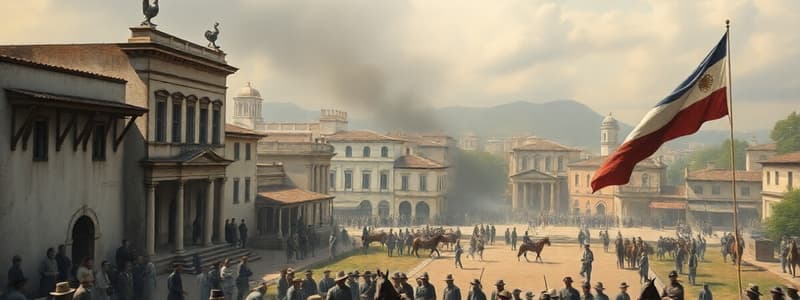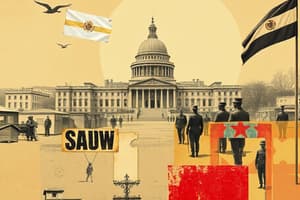Podcast
Questions and Answers
What was the main reason Argentina could not trade freely with other countries during Spanish rule?
What was the main reason Argentina could not trade freely with other countries during Spanish rule?
- Spanish settlers prioritized local production over imports.
- The economy was heavily regulated by Spain. (correct)
- Spain had a strong military presence in the colonies.
- Argentina lacked the necessary ports to facilitate trade.
Which event in Europe significantly weakened Spain's control over its colonies in the early 1800s?
Which event in Europe significantly weakened Spain's control over its colonies in the early 1800s?
- The signing of the Treaty of Paris.
- The American Revolution.
- The abdication of King Ferdinand VII. (correct)
- The establishment of the Viceroyalty of the Río de la Plata.
What was the outcome of the May Revolution in 1810?
What was the outcome of the May Revolution in 1810?
- The Spanish Viceroy was overthrown in Buenos Aires. (correct)
- Total independence from Spain was immediately declared.
- A new king was established for the colonies.
- Buenos Aires became a part of a different Viceroyalty.
Which of the following ideas were spread by the American and French Revolutions that influenced revolutionary thoughts in Argentina?
Which of the following ideas were spread by the American and French Revolutions that influenced revolutionary thoughts in Argentina?
What was the purpose of the Primera Junta?
What was the purpose of the Primera Junta?
What was a key reason some leaders were cautious about declaring full independence for Argentina?
What was a key reason some leaders were cautious about declaring full independence for Argentina?
Why did the people of Buenos Aires begin to question their loyalty to Spain during the Napoleonic Wars?
Why did the people of Buenos Aires begin to question their loyalty to Spain during the Napoleonic Wars?
Before 1776, which Viceroyalty encompassed what is now Argentina?
Before 1776, which Viceroyalty encompassed what is now Argentina?
What major military campaign did José de San Martín lead in 1817?
What major military campaign did José de San Martín lead in 1817?
What role did the Army of the North play during the War for Independence?
What role did the Army of the North play during the War for Independence?
What was celebrated as a major national holiday in Argentina?
What was celebrated as a major national holiday in Argentina?
Which of the following best describes the situation after the May Revolution?
Which of the following best describes the situation after the May Revolution?
Which of the following best describes the economic situation in Buenos Aires during Spanish rule?
Which of the following best describes the economic situation in Buenos Aires during Spanish rule?
Which notable figure is often compared to George Washington in the context of South America's independence?
Which notable figure is often compared to George Washington in the context of South America's independence?
What obstacle did San Martín face while trying to gain independence for Argentina?
What obstacle did San Martín face while trying to gain independence for Argentina?
What was the overall aim of the revolutionaries after the May Revolution?
What was the overall aim of the revolutionaries after the May Revolution?
What event marked the beginning of Argentina's independence movement?
What event marked the beginning of Argentina's independence movement?
Why was 1816 a significant year for Argentina?
Why was 1816 a significant year for Argentina?
What was the primary goal of the Congress of Tucumán in 1816?
What was the primary goal of the Congress of Tucumán in 1816?
What role did San Martín play in the independence of South American countries?
What role did San Martín play in the independence of South American countries?
What continued after the declaration of independence in Argentina?
What continued after the declaration of independence in Argentina?
What external factor greatly influenced Argentina’s path toward independence?
What external factor greatly influenced Argentina’s path toward independence?
What was a key outcome of the Battle of Chacabuco?
What was a key outcome of the Battle of Chacabuco?
How did the revolutionary forces in Argentina gain strength leading to independence?
How did the revolutionary forces in Argentina gain strength leading to independence?
Flashcards are hidden until you start studying
Study Notes
Argentina Under Spanish Rule
- Spain controlled Argentina as part of the Viceroyalty of Peru until 1776.
- The Viceroyalty of the Río de la Plata, established in 1776, included Argentina, Bolivia, Paraguay, and Uruguay.
- Spain heavily regulated trade in its colonies, limiting Argentina's economic potential.
- Ideas of freedom and self-government from the American (1776) and French (1789) revolutions inspired Argentina's desire for independence.
Napoleon's Invasion Sparks Revolution
- Napoleon's invasion of Spain in 1808 weakened the Spanish monarchy and caused turmoil.
- The people of Buenos Aires questioned their loyalty to a Spain unable to protect itself.
The May Revolution (1810)
- On May 25, 1810, the people of Buenos Aires overthrew Spanish Viceroy Baltasar Hidalgo de Cisneros.
- This event is celebrated in Argentina as Revolution Day.
- The First Assembly (Primera Junta) was created as a temporary government, delaying a full declaration of independence.
- Different groups within the revolution had varying opinions on independence, ranging from immediate to cautious.
War for Independence (1810-1816)
- The fight for independence lasted six years between revolutionaries and loyalist Spanish forces.
- The Army of the North was formed to defend the new government and expand the revolution across the Viceroyalty.
- Internal conflicts between regions complicated the war, with differing ideas about independence and leadership.
José de San Martín: A Key Figure
- José de San Martín, a skilled military leader, was a crucial figure in the independence movement.
- He returned to South America in 1812 to aid the fight for independence.
- He believed that Argentina could not be truly free while Spain controlled the rest of South America.
- The Crossing of the Andes, led by San Martín, secured Chile's liberation from Spanish control.
The Declaration of Independence (1816)
- Argentina officially declared its independence from Spain on July 9, 1816, at a Congress in Tucumán.
- The declaration was influenced by Spain's weakened state and the strength of the revolutionary forces.
- The Congress aimed to unite the provinces under one goal for independence.
Aftermath of Independence
- Argentina continued fighting against loyalist forces for several years, especially in the northern regions.
- San Martín continued his campaign to liberate Peru, achieving success in 1821.
- The early 1800s were marked by uncertainty, struggle, and bravery, laying the foundation for an independent Argentina.
Studying That Suits You
Use AI to generate personalized quizzes and flashcards to suit your learning preferences.




